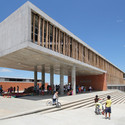ArchDaily has partnered with CEMEX, a global leader in the building materials industry, to bring you a perspective of the industry in latest advances that are relevant for architects. In this article, we examine the role of concrete in the development of forms in architecture.
Concrete is the most used in the artificial world material. And solid plastic, it is likely to be paid in almost any form. Concrete can flow like water flowing in a graceful curve like an icing on a cake online, or jab into the sky like a steep cliff sea. It all depends on how it is mixed.
As splice DNA, specific physical traits can be selected according to the needs of a project. Adjusting the mix or adding exotic materials for waterproof concrete can make or sponge; it can change its acoustic properties, generate energy from footsteps or even clean pollution from the air. Concrete is incredibly versatile. It can even used as ink in giant 3D printers to print buildings.
all depends on the composition of the concrete, on its design. At higher levels of complexity, concrete by design requires the expertise of engineering that can only be developed through experimentation and research. What might begin as an idea in the mind of an architect needs a specific path to construction, such as how the properties of concrete depend on any gathering, through the selection of ingredients, mixing appropriate, transportation, pouring and finishing.
brutalism celebrated all, rocks, fossils and glass fragments bristling with buildings like Paul Rudolph School of Architecture at Yale University. After the concrete panels of the building had been, workers had to attack the bush hammer to reveal the aggregate and sand texture. There is no concrete without Rudolph.
Technically, concrete is a composite of water, granular filler and cement. The water and cement, a lime binding agent and clay, to be there, but the load can be changed, making the concrete a more useful material.
Mixed on site or, more often, in a factory nearby, the concrete can be simplified to reduce weight, semi-transparent to allow light in a building, or even mixed with an insulating material such as lightweight expanded glass to improve its thermal qualities.
The versatility of
The cement may make humans more used and most useful materials invented. As new technologies are developed, the cement can be incorporated more easily than other materials because it is already a mixture. ash waste from power plants is now commonly used in the production of cement, for example; This process saves millions of dollars and reduce the carbon footprint of the production of concrete. You can be sure that all new materials are invented in the future, they will find their way in the experimental cement.
consider these projects, all made possible with the help of CEMEX :.
Follow CEMEX on Twitter, Facebook and Instagram



 9
9
Posting Komentar